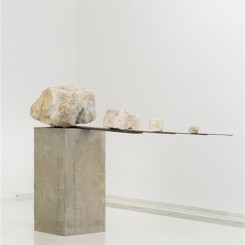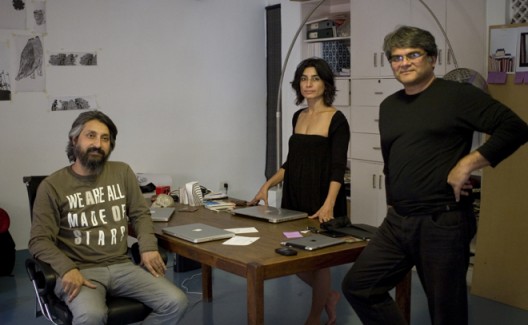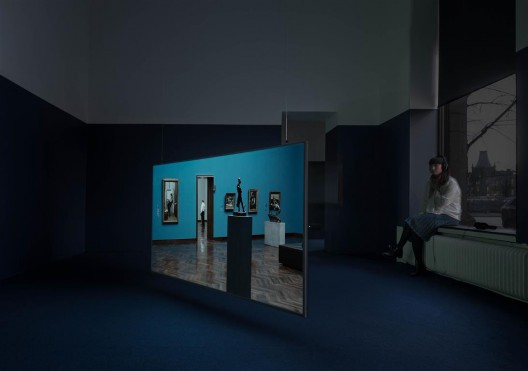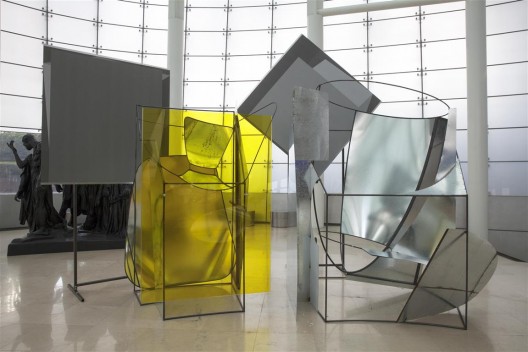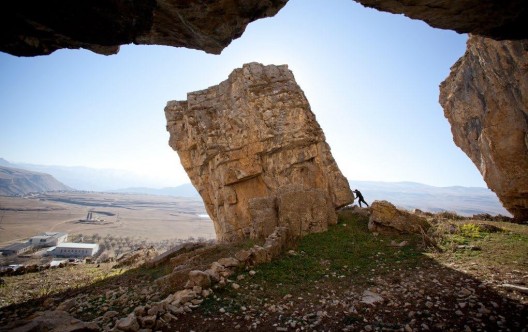This piece is included in Ran Dian’s print magazine, issue 4 (Winter 2016–2017)
Raqs Media Collective is adept at contemplating time. They aim to open up multidimensional spaces to try to counter standardized time as dictated by the global capitalist system. At the time of writing, they were preparing for the Shanghai Biennale, which is the first instance of Raqs taking on the role of curator alone. In this interview, Raqs establishes what could probably be called a “three-body-temporailty”, meaning that the artists will work in a dynamic fashion in order to apply the complex notion of time inherent in contemporary art to various highly complicated and asynchronous landmasses.
Zian Chen: In organizing the biennale, you’ve characterized questioning as an essential tool for curating. You provided notes to the participating artists, and it seems that the notes spread in every direction. Does this suggest the exhibition will be a multitude of layers that could potentially de-center the biennale itself as a vehicle for the circulation of capital?
Raqs Media Collective: Recently, during a discussion held as part of the Athens Biennale, we suggested that it might be worthwhile to research the lineages of contemporary art gatherings and impulses. We offered a lineage that can be traced from the brief celebratory moment of the Paris Commune in 1871. We know from Kristin Ross’s engaging historical investigation of the actions proposed and enacted by the Artists’ Federation of the Paris Commune (in her 2015 book Communal Luxury: The Political Imaginary of the Paris Commune) of the idea of “communal luxury”—a festive mode of becoming for all, a revelry of energies of life for the commons. There is a lot of research and re-imagination to be done that could give rise to some necessary openings. Our notes to artists were in this spirit. Could we together open up new trajectories of inquiry and forms for sensing the world?
As a collective, we draw from a long “walk” across many lands—from 7th-century star charts and 15th-century poetic inventions to a brilliant inchoate film from the turbulent 1970s [Jukti, Takko aar Gappo] and contemporary science fiction [The Three-Body Problem], along with some cosmological threshold questions. The question, after all, is about opening up a space of thought that moves in jagged lines and creates unexpected connections. These may make for a scrambling of received ideas and sentiments as well as new processes of valorization.
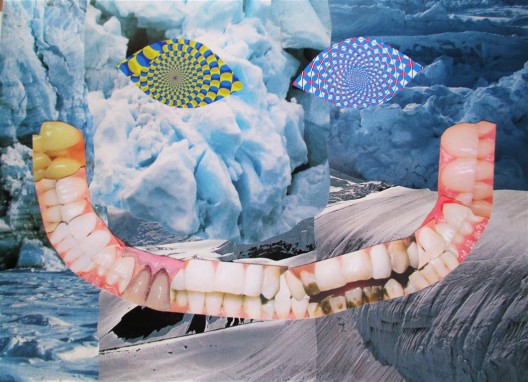
卡尔·马克思,《Gnosmosis》,混合媒介拼贴画,
1280 × 350 cm,2016 / Karl Max, “Gnosmosis”, mixed media collage, 1280 × 350 cm, 2016.
ZC: Does the curatorial idea of “Why Not Ask Again?” reflect upon any specific (or general) condition of either Chinese society or the ecosystem of the biennale?
RMC: We feel that in the current moment, we are at a threshold. The question of “forms of life” has opened up in diverse ways. The urgency of the conditions that human beings encounter at the planetary level requires us to revisit some key questions. Recently, one of us ran a seminar on what it means to be called a human. It is now limiting to adhere to particular geopolitical concerns. To understand China, we have to think of the world; to get a sense of the world, we have to engage with what is happening in China. In a time of pandemics, weather anomalies, contagious political processes, mass migrations, global memes, and emergent networks, each iteration of the biennale form can contribute to a global conversation by being a periodic listening station and a transmitter.
The much-discussed biennale form is here to stay. It has distributed and disturbed the sites of discursive production and forms of collegiality. It has become an incubator for curatorial thinking, uncertain images, ideas, and sensations. Somewhere within biennales there is always an unsettling inquiry about the way we cohere and give and what is proximate, what is laughable and what is joyous in the world, and in ourselves. It’s an ensemble of variegated personal investigations that can even suggest practical measures being taken by people to realize new worlds.
Each personal itinerary is relevant, as we are all part of the same interlocking set of realities. More specifically, we can offer the public in China a thoughtful, conversational, playful experience: an experience of repose, of puzzlement, of disorientation, of disputation, and of care.
ZC: How might the biennale reflect the legacy of the 2010 Shanghai Biennale, with its theme of “Rehearsal,” or other exhibitions that your group has participated in as artists, such as the Bandung Pavilion you made for the 2012 Shanghai Biennale? Might it even reflect your forthcoming presentation in Gwangju?
RMC: “Rehearsal” in 2010 was important because it laid out a reality composed of processes rather than results. A process-oriented, thoughtful, intellectually agile, and questioning spirit is what we found in that moment. The way we have developed the infra-curatorial procedures in this 2016 edition also draws from our reading of the 2012 biennale. The work we made for the Bandung Pavilion with Iswanto Hartono was created through conversations over email. We were surprised by the effect of the work when we saw images of the installation. It was based on trust and a mutual appreciation of our curiosities. We carry that spirit into our other conversations. In Gwangju, we are artists, and it will be an exciting moment for understanding exhibitions imagined and laid out in Asia from many vantage points. It’s great. We strongly feel that the recent history of biennales in Asia—and their continuing presence—are generating new directions.
ZC: How do you situate your curatorial strategy within the wider scope and development of the biennale as a platform for thinking, specifically with reference to works that demand a physical space, or to the Chinese art field in which the works of art are primarily considered as one for productive circulation rather than a means of intellectual reflection?
RMC: Biennales are gatherings where artworks, people, and processes find points of connection, resonance, and even the visceral “connectedness” of disagreement. Thinking can never endure in isolation. Perhaps that is why solitary confinement is such a cruel punishment. We all imagine ourselves in conversation with many protagonists from many eras and folds of time and space. We are layering the space of the buildings and the temporal duration of the biennale through clusters, terminals, passages, detours, and experimental forms of gathering. We hope that the exhibition will offer the dense and layered art field in China something to argue with, and that we will maybe see art being produced with fresh eyes. “Why Not Ask Again?” will provide many opportunities for artworks to think, and to think with artworks.
ZC: It seems that there’s a reference to dialectics in the titular notion of “Arguments, Counter-Arguments and Stories”. Can you explain how the film Jukti, Takko aar Gappo (Arguments, Counter-Arguments and Stories) translates into, or echoes, The Three-Body Problem?
RMC: The subtitle of the exhibition, Maneuvers, Disputations and Stories, references Ritwik Ghatak’s Bengali film from 1974, Jukti, Takko aar Gappo; the title is also (partially) inspired by Liu Cixin’s novel The Three-Body Problem. It suggests a tense alliance between speculation, reason, and the imagination, and between acts, polemics, and fables. What it proposes is something like an atmosphere or ecosystem within which thoughts, images, and acts can thrive and grow in unpredictable and miscegenational trajectories. The dialectic, on the other hand, is a method, or procedure, for synthesizing what appear to be contradictions. With maneuvers, disputations, and stories, we are going away from the procedural arc of the dialectic. This three-movement procedure allows us an expansive arena of thinking as generous, as transversal, as opened out by the science-fiction imagination.
ZC: To ask a question again might mean that the question is both urgent and untimely. Or it might be that the same question is being asked with a new reference: for example, Naomi Klein recently responded to the environmental problem in light of Edward Said. In what way does this edition of the biennale encompass the habitual function of the biennale—that is, reflecting on the societal issues of geography—while at the same time interpreting it in new and different ways?
RMC: It is always rewarding to ask an old question in a new way, or to test a settled question with a newer claim. Naomi Klein, in the recent Edward Said memorial lecture that you refer to, gestures to the dangers of a “green” ethic that recognizes the sovereignty of nature but erases the needs of people. Meanwhile, she also argues that current environmental crises cannot be understood separately from the processes of “othering” that make it possible for entitled global elites to perpetuate the erasure of those who are “sacrificed” at the altar of capital. This is how Klein reads Said—as a set of caveats to the way we frame the ecological question. The caveats, for Klein, are not intended to disarm the question; rather, they serve to strengthen it.
The work of art is to act as both a caveat and as a catalyst. It can disarm frameworks of certainty by insisting on the ethical and epistemic vitality of the intimate, the desired, and the imagined. By doing so, it acts as a caveat to what people think of, or take for granted, as the “real.” Art can help us realize that the real is as much a construct as the imagined. Equally, art can also provoke and call into being entirely new frames for constructing meaning. Here it acts as a catalyst. We are free to imagine other worlds because we engage closely with this one. We can be generous and expansive with time by paying close attention to the way the varied temporalities of different works overlap and develop experiences of syncopation, just as musicians in a jazz ensemble find ways to cohabit different tempi and rhythms. We hope the biennale will play truant with common-sense assumptions of how we live, and how we might live.
ZC: How will your proposed thematic methods—for example, Maneuvers, Disputations and Stories—be translated into the visual experience?
RMC: Here we can say that there will be some room for surprises! We enjoy following the paths of various protagonists, and hopefully the exhibition will be able to express that. This is not a thematic exhibition; it will follow a procedure of dense, braided lines with bursts of singular eruption. The linkages will be part spectral and part precise. We hope that visitors will enjoy a spin and a charge.
ZC: I always appreciate that, in your group practice, there is a sense of understanding the changing world with wisdom that, for me, is shaped largely by a culture with long-standing traditions. How do you situate your thinking in relation to hot topics in the art world; for example, the Anthropocene, the post-internet, and the extreme version of Marxism called accelerationism? The key for me in asking this question is the accelerationists’ investment in the field of science fiction. How do you understand the role of sci-fi in the Shanghai Biennale’s curatorial dialog?
RMC: As we expressed earlier, we are at a threshold. Teleological uncertainty has existed for the last thirty years. The machine-to-human relationship, the nature of humans, and the place of humans within nature have all become extremely confusing. Most current theoretical adventures are trying to grapple with this blurry and bloody moment. Accelerationism has many insights, but somewhere it seems to assume the diminution of minds, wills, and bodies as it examines the delirious swelling of the machine. This image of diminution can have a debilitating effect on life. We will try to bring in the lineages of “communal luxury” and “in praise of idleness” [as drawn from Bertrand Russell’s essay of the same title, published in 1932, as well as Paul Lafargue’s “The Right to Be Lazy,” published in 1883 —Ed.] as a way to enter these passages in our contemporary moment.
The Anthropocene is an intriguing intellectual and cultural intervention into science. But it has produced a conundrum of naming. It brings collective blame onto the whole of the Anthros. For example, recently we were in a whaling museum. It’s a story in which the sort-of equal battle between man and beast is erased by the coming of the machine. A form of life destroyed many forms of life to produce the conditions that are being called the Anthropocene. We are certain that this debate will become more layered in coming years, when—crucially—men and women from diverse histories and geographies will enter into it and transform it.
Capital’s demand for energy from fossils and humans is insatiable. Most current geopolitical turbulences are emerging from exhaustion as much as they are being driven by further possibilities of life. We need to be cautious about how we understand these debates. Nineteenth-century philosophers and writers thought through topical questions about the forces that had begun to visibly affect human life. These questions are being revisited, and fresh accounts are emerging. We know for sure that we know less about what sculpts us now. Art is an account of this un-knowing.
An oxygen crisis occurred on this planet before. The Permian extinction, which wiped out the majority of life forms about 252 million years ago, was in fact caused by “global warming” produced by a form of life (Archaea, a type of methanogenic, or methane-producing, microorganism), the descendants of which still inhabit human intestines. This, in turn, was a reaction to an “oxygen crisis”—ironically, the production of too much toxic oxygen. This began happening when an explosion of early plant life caused an enormous boost in oxygen levels in the earth’s atmosphere as a result of explosions in photosynthesis levels.
We could tell this story as folklore, or as science fiction, of the tussle between forms of life and between different acts of breathing that end up completely changing the earth.
About the writer
Zian Chen (1986) writes fictions depicting objects from the contemporary art world, whereas his review writing anticipates new approaches of criticism and readership in the light of literature. His exhibtion-novel was given the Contemporary Art Writing and Critical Thinking Award by Fondation Prince Pierre de Monaco in 2015.
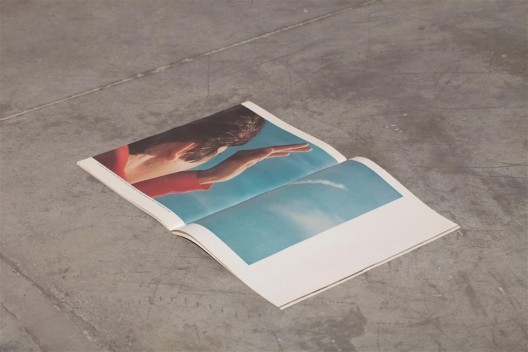
谢蓝天,《停在外面的车子》,大众桑塔纳、选用了萨拉赫·拉杰卜的埃及爵士乐、选用了李·摩根的响尾蛇导弹、《生活》杂志,尺寸可变,2016
(版权归谢蓝天和迪拜的灰噪画廊所有)/ Lantian Xie, “A car parked outside”, Volkswagen Santana, excerpt from Egyptian Jazz by Salah Ragab, excerpt from Sidewinder by Lee Morgan, LIFE magazine, dimensions variable, 2016. © Lantian Xie and Grey Noise, Dubai.
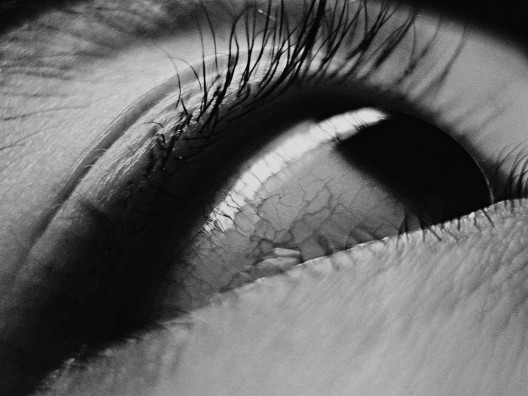
陈哲,《回忆忘记,忘记回忆(再访“可承受的”)》,摄影,400 × 300 cm,2007/2016 / Chen Zhe, “Remembering the Forgotten, Forgetting the Remembered (Revisiting “The Bearable”)”, 400 × 300 cm, 2007/2016.
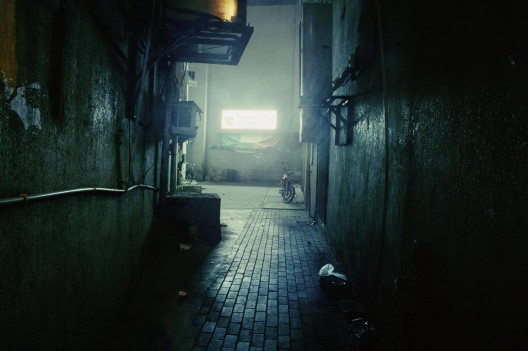
亚赞·哈利利,《A区的打劫》,旋转式幻灯放映
机 、视频投影机,尺寸可变,2013–2016 / Yazan Khalili, “Robbery in Area A”, carousel projector, video projectors, dimensions variable, 2013–2016.
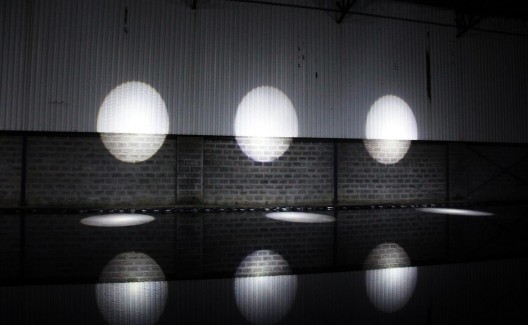
维莎·达尔,《马尔殊—暴风之神》,带有聚光灯和倒影池的场域定制装置 / Vishal Dar, “Maruts – Storm Deities”, 2016. site-specific installation with beam lights and reflection pool
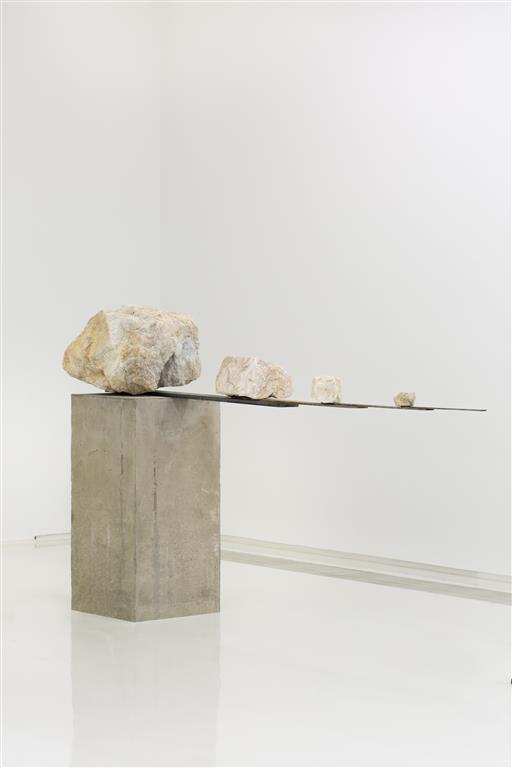
廖斐,《延伸的直线》,大理石、钢板、灯泡,
275 × 70 × 160 cm,2015 / Liao Fei, “A Straight Line Extended”, marbles, steel plates, bulb, concrete base, robot arm, 275 × 70 × 160 cm, 2015.

